9 rental property tips for homeowners

1. Allocate expenses and income for co-owned properties.
If you co-own a rental property, you must declare rental income and claim expenses according to your legal ownership of the property. As joint owners, your legal interest will be an equal split, and as tenants in common you may have different ownership interests.
2. Make your property rentable.
If your rental is currently empty, you can still claim deductions. However, your property must be genuinely available for rent. This means you have to show a clear intent to rent the property, such as:
- Listing the property on rental sites.
- Ensuring the rent of that listing is fair and aligned with similar properties in the area.
- Ensuring the property is liveable (clean, maintained, safe).
This is to avoid people using their rental property as a holiday home (or other purpose), but saying it’s a rental just to claim the relent tax benefits.
3. Understand repairs and improvements.
Ongoing repairs for wear and tear can be claimed in full in the same year you incurred the expense. For example, repairing the hot water system or part of a damaged roof can be deducted immediately. Initial repairs for damage that existed when the property was purchased, such as replacing broken light fittings and repairing damaged floorboards, are not immediately deductible. But, a deduction may be claimed over a number of years as a capital works deduction.
Replacing an entire structure — like the whole roof when only part of it was damaged — or renovating a bathroom is classified as an improvement and not immediately deductible. These are building costs which you can claim at 2.5% each year for 40 years from the date of completion. If you completely replace a damaged item that is detachable from the house and it costs more than $300 (e.g, replacing the entire hot water system) the cost must be depreciated over a number of years.
4. Get construction costs right.
On top of improvements and repairs, you can claim certain building costs, including extensions, alterations and structural improvements as capital works deductions. As a general rule, you can claim a capital works deduction at 2.5% of the construction cost for 40 years from the date the construction was completed.
If your property was previously owned by someone else, and they claimed capital works deductions, they should provide you with the details needed to correctly calculate the deduction you're entitled to claim. If you can't obtain those details from the previous owner, engage a professional who can estimate previous construction costs.
5. Understand borrowing expenses & purchase costs.
Borrowing expenses include loan establishment fees, title search fees, and costs of preparing and filing mortgage documents. If these expenses are over $100, the deduction is spread over five years. If they are $100 or less, you can claim the full amount in the same income year you incurred the expense.
You can't claim any deductions for the costs of buying your property. These include conveyancing fees and stamp duty (for properties outside the ACl). If you sell your property, these costs are then used when working out whether you need to pay capital gains tax.
6. Understand how to claim interest on your loan.
You can claim interest as a deduction if you take out a loan for your rental property. If you use some of the loan money for personal use such as buying a boat or going on a holiday, you can't claim the interest on that part of the loan. You can only claim the part of the interest that relates to the rental property.
7. Ensure you claim correctly if you rent below market rate.
If your rental property is rented out below market rate (for example, many people rent their property to family and friends at a cheaper rate), you can only claim a deduction for that period up to the amount of rent you received. You can't claim deductions when your family or friends stay free of charge, or for periods of personal use.
8. Keep accurate records.
You must have evidence of your income and expenses so you can claim everything you are entitled to. Capital gains tax may apply when you sell your rental property. In fact, you should keep records over the period you own the property and for five years from the date you sell the property.
9. Get capital gain right when you sell.
When you sell your rental property, you may make a capital gain or a capital loss. This is the difference between what it cost you to buy and improve the property, and what you receive when you sell it. But, your costs don’t include amounts already claimed as a deduction against rental income earned from the property, including depreciation and capital works.
If you make a capital gain, you will need to include the gain in your tax return for that income year. If you make a capital loss, you can carry the loss forward and deduct it from capital gains in later years.
We’ve got even more insights for you
To hear them, let’s chat. We’ll go deeper into how owning a rental property can be used in your tax return and answer any questions you might have. Contact us to get started.
Need help with your accounting?








